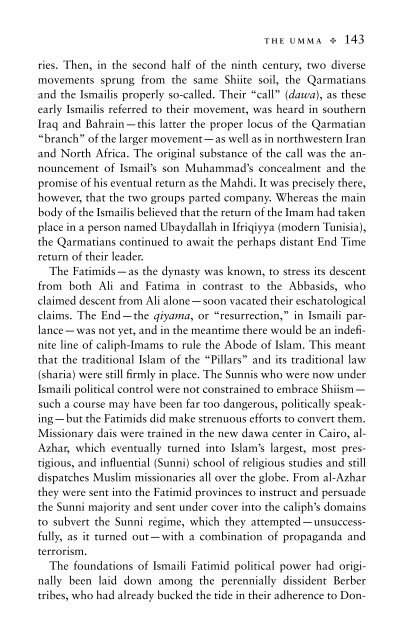Islam: A Guide for Jews and Christians - Electric Scotland
Islam: A Guide for Jews and Christians - Electric Scotland
Islam: A Guide for Jews and Christians - Electric Scotland
You also want an ePaper? Increase the reach of your titles
YUMPU automatically turns print PDFs into web optimized ePapers that Google loves.
THE UMMA t 143<br />
ries. Then, in the second half of the ninth century, two diverse<br />
movements sprung from the same Shiite soil, the Qarmatians<br />
<strong>and</strong> the Ismailis properly so-called. Their “call” (dawa), as these<br />
early Ismailis referred to their movement, was heard in southern<br />
Iraq <strong>and</strong> Bahrain—this latter the proper locus of the Qarmatian<br />
“branch” of the larger movement—as well as in northwestern Iran<br />
<strong>and</strong> North Africa. The original substance of the call was the announcement<br />
of Ismail’s son Muhammad’s concealment <strong>and</strong> the<br />
promise of his eventual return as the Mahdi. It was precisely there,<br />
however, that the two groups parted company. Whereas the main<br />
body of the Ismailis believed that the return of the Imam had taken<br />
place in a person named Ubaydallah in Ifriqiyya (modern Tunisia),<br />
the Qarmatians continued to await the perhaps distant End Time<br />
return of their leader.<br />
The Fatimids—as the dynasty was known, to stress its descent<br />
from both Ali <strong>and</strong> Fatima in contrast to the Abbasids, who<br />
claimed descent from Ali alone—soon vacated their eschatological<br />
claims. The End—the qiyama, or “resurrection,” in Ismaili parlance—was<br />
not yet, <strong>and</strong> in the meantime there would be an indefinite<br />
line of caliph-Imams to rule the Abode of <strong>Islam</strong>. This meant<br />
that the traditional <strong>Islam</strong> of the “Pillars” <strong>and</strong> its traditional law<br />
(sharia) were still firmly in place. The Sunnis who were now under<br />
Ismaili political control were not constrained to embrace Shiism—<br />
such a course may have been far too dangerous, politically speaking—but<br />
the Fatimids did make strenuous ef<strong>for</strong>ts to convert them.<br />
Missionary dais were trained in the new dawa center in Cairo, al-<br />
Azhar, which eventually turned into <strong>Islam</strong>’s largest, most prestigious,<br />
<strong>and</strong> influential (Sunni) school of religious studies <strong>and</strong> still<br />
dispatches Muslim missionaries all over the globe. From al-Azhar<br />
they were sent into the Fatimid provinces to instruct <strong>and</strong> persuade<br />
the Sunni majority <strong>and</strong> sent under cover into the caliph’s domains<br />
to subvert the Sunni regime, which they attempted—unsuccessfully,<br />
as it turned out—with a combination of propag<strong>and</strong>a <strong>and</strong><br />
terrorism.<br />
The foundations of Ismaili Fatimid political power had originally<br />
been laid down among the perennially dissident Berber<br />
tribes, who had already bucked the tide in their adherence to Don-
















